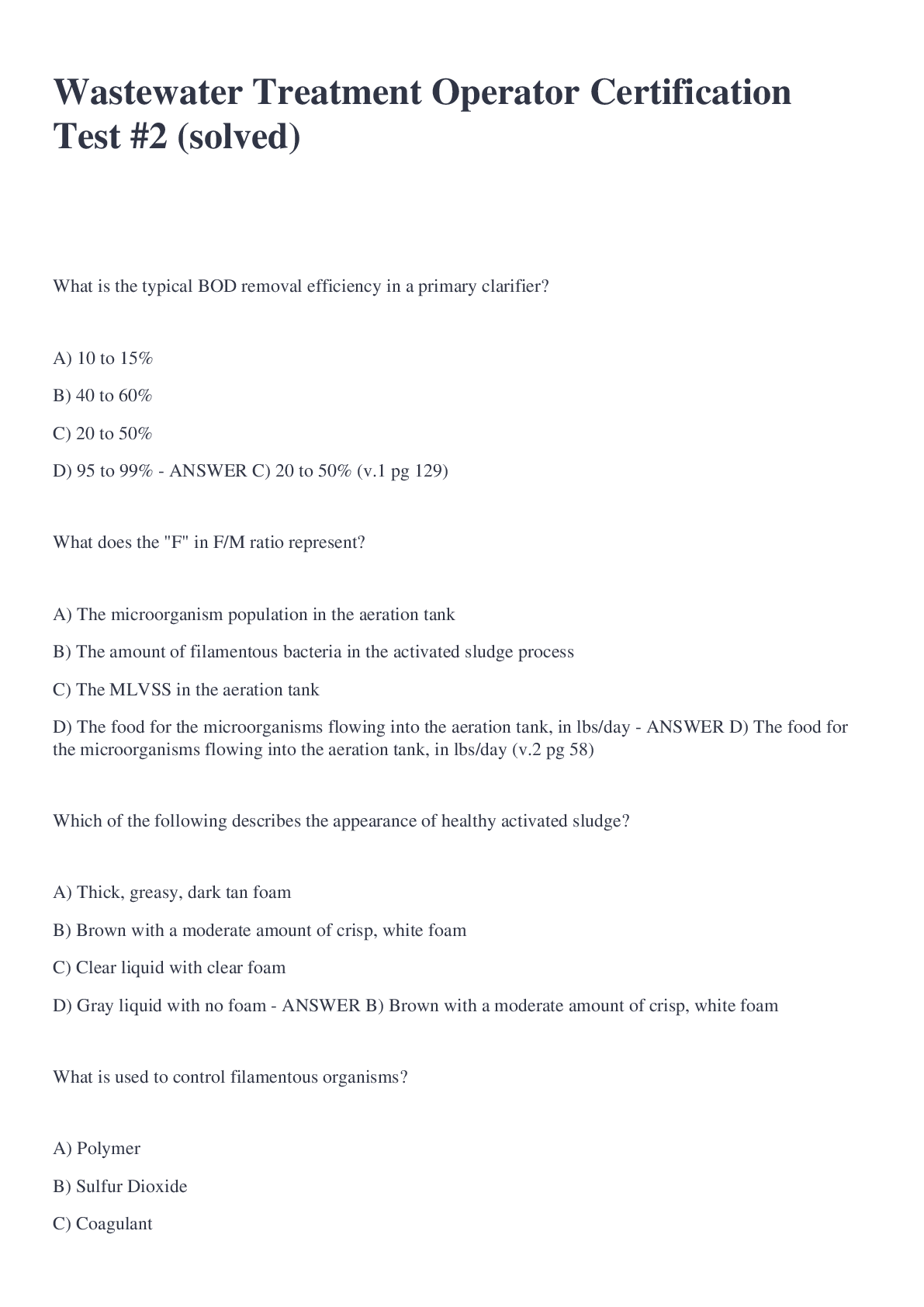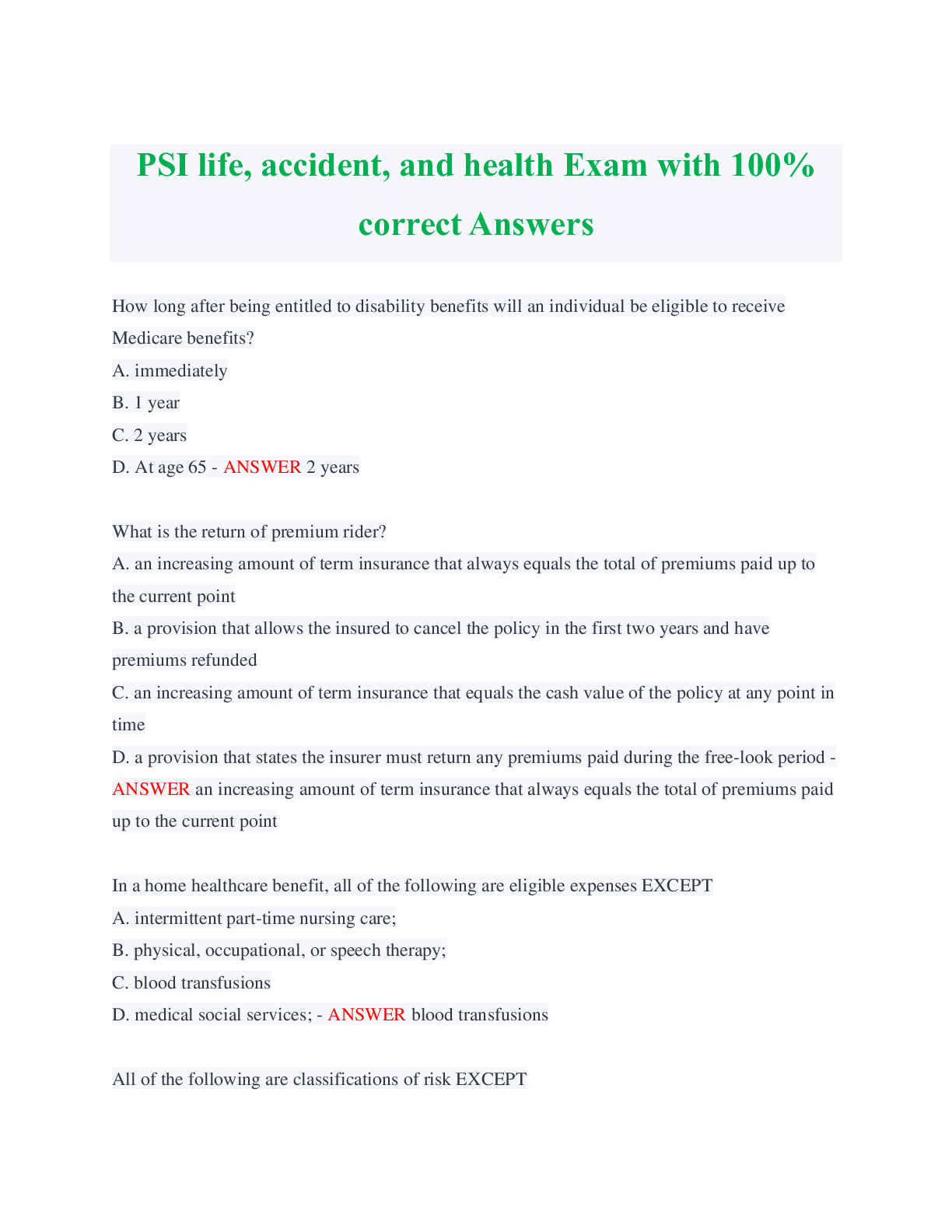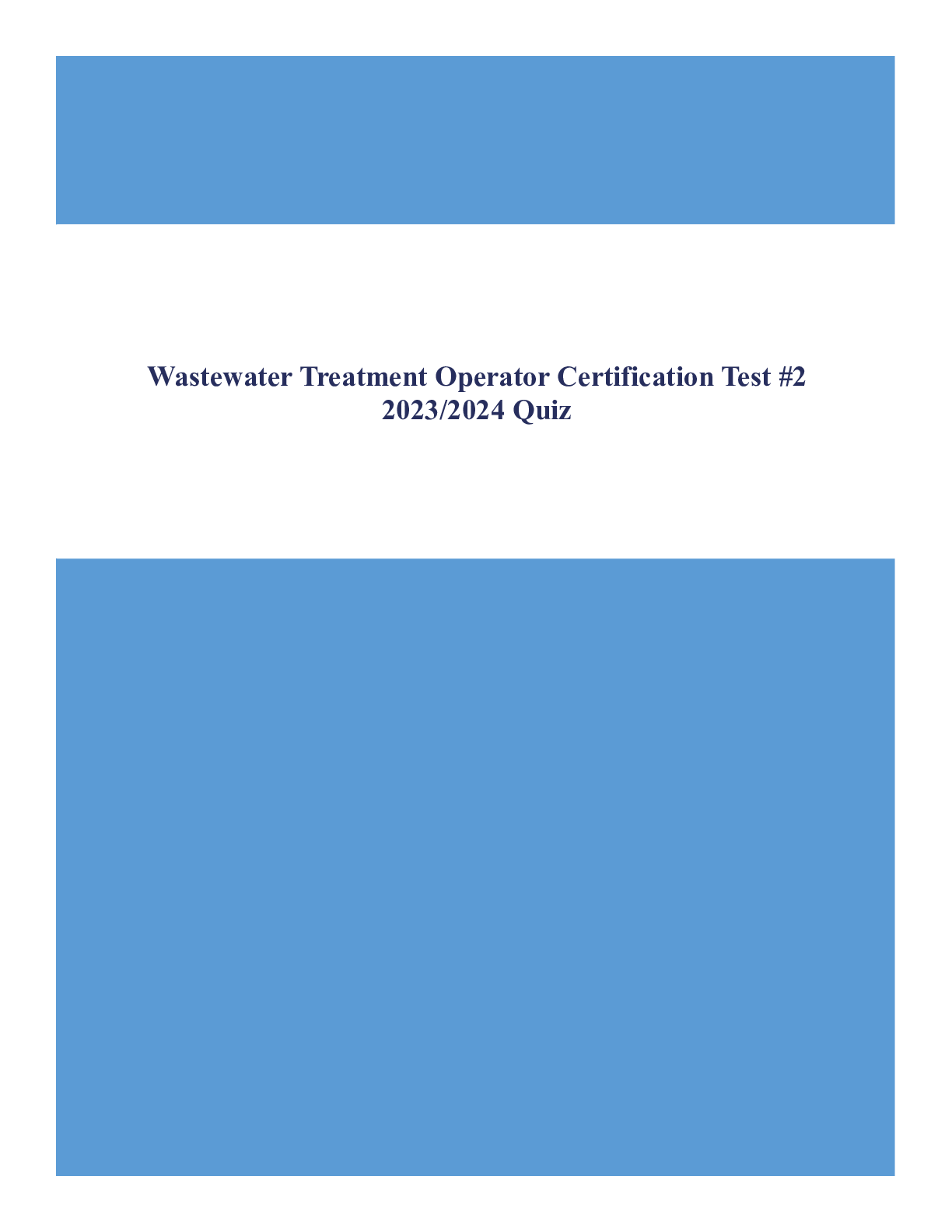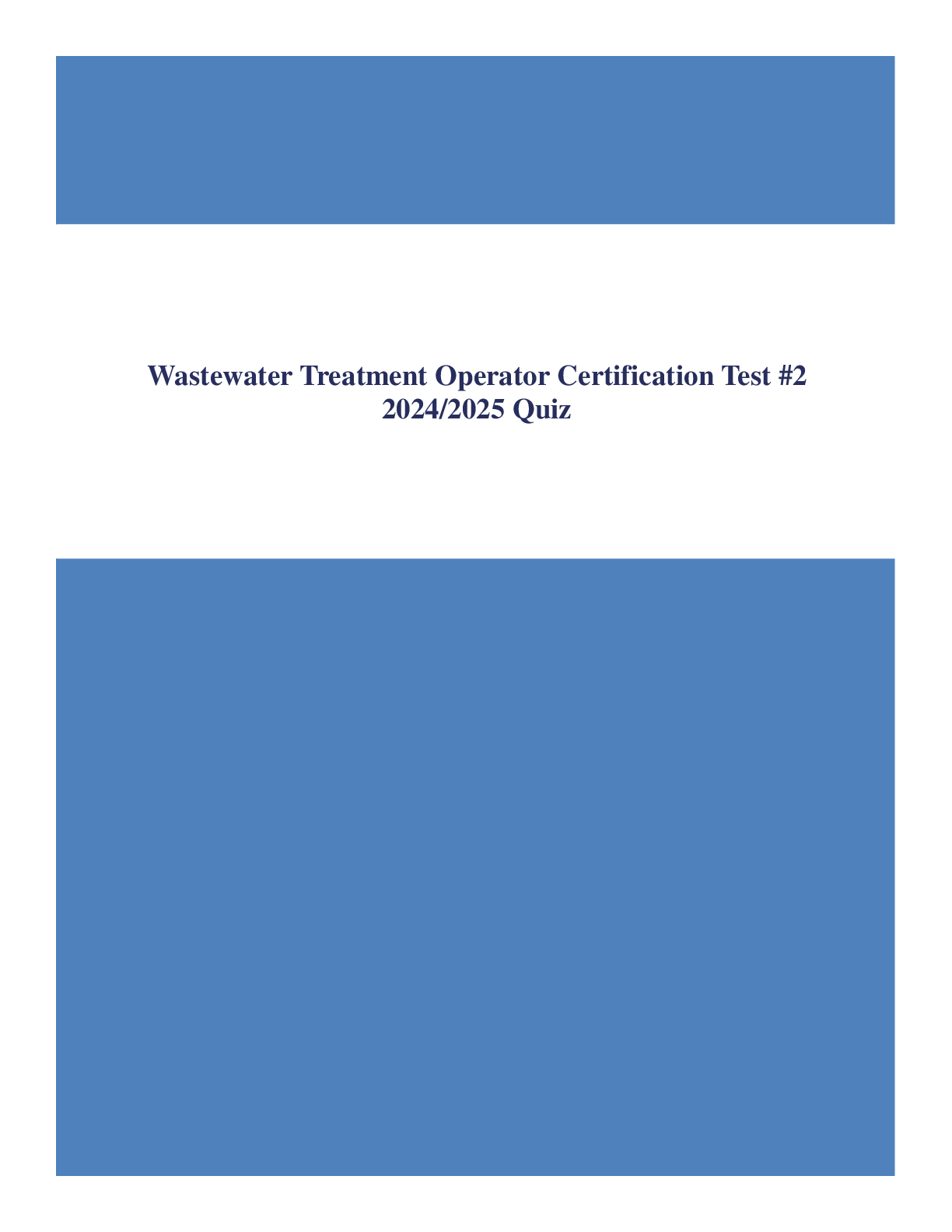Wastewater Treatment Operator Certification Test #2 (solved)
Document Content and Description Below
What is the typical BOD removal efficiency in a primary clarifier? A) 10 to 15% B) 40 to 60% C) 20 to 50% D) 95 to 99% - ANSWER C) 20 to 50% (v.1 pg 129) What does the "F" in F/M ratio repres... ent? A) The microorganism population in the aeration tank B) The amount of filamentous bacteria in the activated sludge process C) The MLVSS in the aeration tank D) The food for the microorganisms flowing into the aeration tank, in lbs/day - ANSWER D) The food for the microorganisms flowing into the aeration tank, in lbs/day (v.2 pg 58) Which of the following describes the appearance of healthy activated sludge? A) Thick, greasy, dark tan foam B) Brown with a moderate amount of crisp, white foam C) Clear liquid with clear foam D) Gray liquid with no foam - ANSWER B) Brown with a moderate amount of crisp, white foam What is used to control filamentous organisms? A) Polymer B) Sulfur Dioxide C) Coagulant D) Chlorine - ANSWER D) Chlorine (v.1 pg 399) What are commonly used to control chlorine feed rate for disinfection? A) BOD and MLVSS B) pH and temperature C) Flow and chlorine residual D) DO and TSS - ANSWER C) Flow and chlorine residual (v.1 pg 356) Which toxic gas is commonly found in septic wastewater and smells like rotten eggs? A) Hydrogen Sulfide B) Carbon monoxide C) Hydrogen D) Carbon Dioxide - ANSWER A) Hydrogen Sulfide (v.2 pg 299) What is the permissible exposure limit for chlorine gas vapor during a normal 8 hour workday and a 40 hour work week? A) 0.1 ppm B) 0.5 ppm C) 1 ppm D) 15 ppm - ANSWER B) 0.5 ppm (v.2 pg 268) What is a vulnerability assessment? A) Assesses the impact of hydrogen sulfide to a concrete structure B) Analyzes the impact of flow and infiltration problem to the plant hydraulics C) Estimates the vulnerability of aquatic wildlife to excessive algae growth D) Contingency planning to determine the vulnerability of the utility during various types of emergencies and identify corrective actions to reduce the risks - ANSWER D) Contingency planning to determine the vulnerability of the utility during various types of emergencies and identify corrective actions to reduce the risks (v.2 pg 722) What is the difference between the settling rate of activated sludge and raw sludge? A) Activated sludge settles slightly faster than raw sludge B) Activated sludge settles at the same rate as raw sludge C) Activated sludge settles slower than raw sludge D) Activated sludge settles much faster than raw sludge - ANSWER C) Activated sludge settles slower than raw sludge (v.1 pg 109) What should be mostly found in healthy activated sludge? A) Tiny flagellates B) Amoeboids C) Short Filaments D) Free swimmers and stalked ciliates - ANSWER D) Free swimmers and stalked ciliates (v.2 pg 120,124) One to two percent of the digester gas in an anaerobic consists of A) Hydrogen, Nitrogen, Hydrogen sulfide, and other gases B) Methane C) Carbon Dioxide D) CH_4 - ANSWER A) Hydrogen, Nitrogen, Hydrogen sulfide, and other gases (v.2 pg 158) What is true during the colder winter months? A) Modify operations to decrease solids under aeration to provide less microorganisms to treat the BOD B) Modify operations to increase solids under aeration to provide more microorganisms to treat the BOD C) Biological activity will increase, which results in more overall sludge production D) Microorganisms become more active - ANSWER B) Modify operations to increase solids under aeration to provide more microorganisms to treat the BOD (v.2 pg 71) What type of sludge would you expect in an aeration tank if the content is dark and has low DO? A) Sludge that is heavy B) Chlorinated Sludge C) Septic Sludge D) Healthy Sludge - ANSWER C) Septic Sludge (v.2 pg 75) What could have happen if the volatile acid/alkalinity ratio starts to increase, and corrective action is not taken immediately? A) Carbon dioxide content in the digester gas will decrease B) Carbon monoxide content in the digester gas will fluctuate C) pH of the digester sludge will increase D) Carbon dioxide content in the digester gas will increase - ANSWER D) Carbon dioxide content in the digester gas will increase (v.2 pg 191) What are screenings? A) Colloids B) TDS C) Pieces of wood, roots, rags, and other large debris D) COD - ANSWER C) Pieces of wood, roots, rags, and other large debris (v.1 pg 41) What happens when there is more food in the influent to the aeration tank? A) Less oxygen is required in the aeration tank B) More oxygen is required in the aeration tank C) Less organism activity takes place D) Less oxidation takes place - ANSWER B) More oxygen is required in the aeration tank (v.2 pg 19) What impact does temperature have on the reaction rate of microorganisms in wastewater? A) Reaction rate doubles with every 18 degree Fahrenheit increase in temperature until higher temperature inhibits biological activity B) Reaction rate decreases by 20% with every 10 degree Fahrenheit increase in temperature C) Reaction rate of microorganism is not impacted by temperature D) Reaction rate goes to zero - ANSWER A) Reaction rate doubles with every 18 degree Fahrenheit increase in temperature until higher What is commonly used to control the odor of hydrogen sulfide? A) Carbon Dioxide B) Methane C) Chlorine D) Hydrogen - ANSWER C) Chlorine (v.1 pg 398) What is used to determine the amount of microorganisms in the aeration tank? A) Mixed Liquor Suspended Solids (MLSS) B) Influent TSS C) BOD D) Mixed Liquor Volatile Suspended Solids (MLVSS) - ANSWER D) Mixed Liquor Volatile Suspended Solids (MLVSS) (v.2 pg 58) What could happen if the sludge line is isolated by closing the valves on each end for several days? A) It could result in water hammer B) Cavitation C) Gas production could increase the internal pressure and cause the line to fail D) The aerobic condition will cause Zoolgleal mass to grow in large numbers. - ANSWER C) Gas production could increase the internal pressure and cause the line to fail (v.2 pg 152) Which is true about chlorine gas? A) It is 2.5 times lighter than air B) it is 2.5 times heavier than air C) It is 1.5 times heavier than air D) It is 1.5 times lighter than air - ANSWER B) it is 2.5 times heavier than air (v.1 pg 375) Which of the following is typically treated by biological processes? A) Roots and rags B) Sand and eggshells C) Cinders D) Dissolved and non settable organic material - ANSWER D) Dissolved and non settable organic material (v.1 pg 46) Which document is a written record that accurately traces the custody of wastewater samples through all phases of a monitoring program? A) Wastewater Lab Analysis form B) NEPA C) Chain of Custody form D) Diagnostic form - ANSWER C) Chain of Custody form (v.2 pg 498) What could cause a sudden drop in pH of the influent? A) Acidic chemical in the influent B) A strong base was dumped into the collection system C) Ammonia from a factory was discharged into the sewer D) The influent contained sodium hydroxide - ANSWER A) Acidic chemical in the influent (v.2 pg 579) What is the recommended daily maintenance activity for a clarifier? A) Dewater the clarifier by draining the wastewater B) Repaint metal surfaces that have lost their protective coating C) Hose down walls, floor and equipment inside the clarifiers D) Inspect chains, sprockets, and flights. - ANSWER D) Inspect chains, sprockets, and flights (v.1 pg 118) Which of the following could be the cause of ponding in a trickling filter? A) Hydraulic loading is too low B) Clogging of distributor orifices C) Excessive organic loading D) Denitrification - ANSWER C) Excessive organic loading (v.1 pg 192) What could happen if the dissolved oxygen content in the aeration tank is too low? A) Pinpoint floc will develop B) Filamentous organisms could thrive and prevent the sludge sludge floc from settling properly in the secondary clarifier C) Settling will improve in the secondary clarifier D) Sludge bulking will be eliminated - ANSWER B) Filamentous organisms could thrive and prevent the sludge sludge floc from settling properly in the secondary clarifier (v.1 pg 254) What is the expected BOD removal efficiency in a facultative pond? A) Mostly between 40 to 50% B) Mostly between 30 to 40% C) Mostly between 20 to 30% D) Mostly between 70 to 80% - ANSWER D) Mostly between 70 to 80% (v.1 pg 317) What is a chloramine? A) Free chlorine B) A chemical that is formed when chlorine reacts with iron C) Combined chlorine- a chemical that is formed when chlorine reacts with ammonia D) A chemical that is formed when chlorine reacts with air. - ANSWER C) Combined chlorine- a chemical that is formed when chlorine reacts with ammonia (v.1 pg 350) What is sludge bulking in an activated sludge process? A) When mixed liquor solids settle slowly and compact to a limited extent B) When old sludge denitrify and cause sludge to rise as a result of gastrification C) When sludge form large aggregates and cause sludge to settle quickly D) When compaction in the secondary clarifier is improved due to chemical injection - ANSWER A) When mixed liquor solids settle slowly and compact to a limited extent (v.2 pg 71) What is the most common imbalance in an anaerobic digester? A) Excess methane formation B) Excess nitrogen formation C) Excess acid formation D) Excess carbon dioxide formation - ANSWER C) Excess acid formation (v.2 pg 148) What is the only reliable method of detecting hydrogen sulfide? A) Sense of smell B) Atmospheric monitoring C) Color titration D) Lab test - ANSWER B) Atmospheric monitoring (v.2 pg 271) What is sludge age? A) An expression of the average time that a microorganism will spend in the activated sludge process, and calculated using total suspended solids removed from the process B) A measure of food provided to bacteria in an aeration tank C) The theoretical time required for water to pass through a tank at any given flowrate D) A rough indicator of the length of time a pound of solids is maintained under aeration - ANSWER D) A rough indicator of the length of time a pound of solids is maintained under aeration (v.2 pg 519) What is one of the benefits of a COD test over a BOD test? A) COD test does not require any chemicals to perform the test B) COD test will easily predict the effects of an effluent on the DO in receiving waters C) Shorter test period D) COD test is capable of measuring the biodegradability of matter - ANSWER C) Shorter test period (v.2 pg 541) What is the typical detention time for a primary clarifier? A) 3 to 4 hours B) 30 minutes C) 6 hours D) 1.5 to 2 hours - ANSWER D) 1.5 to 2 hours (v.1 pg 43) If you are testing the pH of a wastewater sample, what is the maximum recommended holding time? A) 5 days B) It must be tested immediately C) 24 hours D) 36 hours - ANSWER B) It must be tested immediately (v.2 pg 502) What could cause short circuiting in a clarifier? A) Sludge composition B) Reduction in flowrate C) Uneven weir settings D) Broken sludge pump - ANSWER C) Uneven weir settings (v.1 pg 125) What could cause the slime growth on a rotating biological contactor to appear black? A) It could indicate solids or organic overloading B) High DO in the plant effluent C) Lack of BOD in the influent to the rotating biological contactor D) Low hydraulic loading - ANSWER A) It could indicate solids or organic overloading (v.1 pg 228) What is an air gap? A) A distance between blowers in an activated sludge system B) The vertical distance between the surface of wastewater and the top of basin C) Backflow prevention D) Type of aeration equipment - ANSWER C) Backflow prevention (v.1 pg 503) Which is true about chlorine demand? A) Chlorine demand= Chlorine residual + Chlorine dose B) Chlorine demand= Chlorine does x Chlorine residual C) Chlorine demand= Chlorine residual - Chlorine dose D) Chlorine demand= Chlorine dose - Chlorine residual - ANSWER D) Chlorine demand= Chlorine dose - Chlorine residual (v.1 pg 352) What is accomplished by the activated sludge process? A) Anaerobic bacteria use SO_4 to eat incoming volatile solids B) Remove soluble or finely divided suspended materials C) Anoxic microorganisms destroy incoming BOD D) Zoogleal breaks down influent organics - ANSWER B) Remove soluble or finely divided suspended materials (v.2 pg 16) What is the carbon dioxide content of a properly functioning anaerobic digester? A) 65 to 70% by volume B) 1 to 2% by volume C) 30 to 35% by volume D) 40 to 60% by volume - ANSWER C) 30 to 35% by volume (v.2 pg 158) Which of the following is a collection of individual samples obtained at regular intervals? A) Grab B) Culmination C) Comprehensive D) Composite - ANSWER D) Composite (v.2 pg 499) What is the most common piece of laboratory equipment, which is used mainly to mix chemicals and measure approximate volumes? [Show More]
Last updated: 2 years ago
Preview 1 out of 19 pages

Buy this document to get the full access instantly
Instant Download Access after purchase
Buy NowInstant download
We Accept:

Reviews( 0 )
$8.00
Can't find what you want? Try our AI powered Search
Document information
Connected school, study & course
About the document
Uploaded On
Oct 13, 2022
Number of pages
19
Written in
Additional information
This document has been written for:
Uploaded
Oct 13, 2022
Downloads
0
Views
83



















